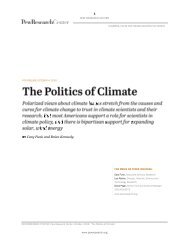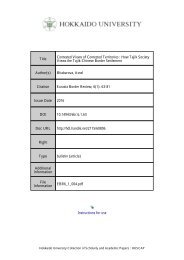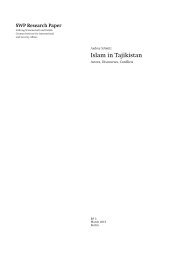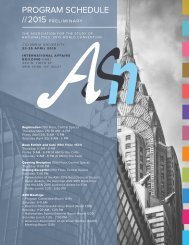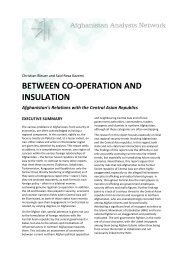Afghanistan in 2015 1
mM5Zmj
mM5Zmj
Create successful ePaper yourself
Turn your PDF publications into a flip-book with our unique Google optimized e-Paper software.
SECURITY 35<br />
The percentage of residents who report some level of fear for personal safety is highest <strong>in</strong> the South<br />
West (84.6%) and South East (81.1%) regions, where clashes with AOGs have been most frequent.<br />
This prevalence of fear is similar to the rate of fear reported by residents of the country’s most <strong>in</strong>secure<br />
areas (80.6%), who were surveyed through <strong>in</strong>tercept <strong>in</strong>terviews. Notably, there is significant variation<br />
<strong>in</strong> both the rate and direction of level of fear across regions and <strong>in</strong>dividual prov<strong>in</strong>ces. The percentage<br />
of residents <strong>in</strong> the South West region who reported some level of fear for personal safety <strong>in</strong>creased by<br />
more than 11 percentage po<strong>in</strong>ts when compared to 2014, while the percentage of residents of the West<br />
region who report some level of fear decreased by more than 10 percentage po<strong>in</strong>ts (to 68.5%) dur<strong>in</strong>g<br />
the same period.<br />
The prov<strong>in</strong>ces most likely to report some level of fear for personal safety are Wardak (96.2%), Logar<br />
(90.6%), and Uruzghan (90.4%). For several years, these prov<strong>in</strong>ces have faced significantly higher<br />
levels of violence and armed <strong>in</strong>surgency than other areas. Prov<strong>in</strong>ces least likely to report some level of<br />
fear are Panjshir (7.2%), Bamyan (18.4%), and Badakhshan (21.7%). The Taliban ma<strong>in</strong>ta<strong>in</strong> little to no<br />
presence <strong>in</strong> Panjshir and Bamyan relative to other prov<strong>in</strong>ces. Both prov<strong>in</strong>ces are populated by ethnic<br />
m<strong>in</strong>ority groups with little support for the Taliban. Bamyan consists primarily of Hazaras, 11 who were<br />
persecuted under the Taliban regime. Panjshir and Badakhshan are primarily populated by Tajiks and<br />
supportive of the Northern Alliance, a coalition of commanders opposed to the Taliban.<br />
Among <strong>Afghanistan</strong>’s major ethnic groups, Pashtuns cont<strong>in</strong>ue to be most likely to report experienc<strong>in</strong>g<br />
fear (77.3%), as violent attacks are more concentrated <strong>in</strong> predom<strong>in</strong>antly Pashtun areas, particularly<br />
along the border with Pakistan. This represents a significant <strong>in</strong>crease from 2013, when 66.5% of<br />
Pashtuns reported experienc<strong>in</strong>g fear (either sometimes, often, or always). The correspond<strong>in</strong>g level of<br />
fear <strong>in</strong> <strong>2015</strong> among other ethnic groups is 65.3% for Uzbeks, 59.8% for Tajiks, and 58.3% for Hazaras.<br />
Other demographic factors, <strong>in</strong>clud<strong>in</strong>g gender, education, marital status, and <strong>in</strong>come also <strong>in</strong>fluence the<br />
level of perceived safety. Women (71.8%) are more likely than men (62.4%) to report feel<strong>in</strong>g some fear<br />
for their personal safety. Afghans are significantly more likely to cite fear for personal safety if they have<br />
more education, if they are married, and if their household <strong>in</strong>come has decl<strong>in</strong>ed relative to last year.<br />
As expected, Afghans who report lower confidence <strong>in</strong> the ability of the ANSF to keep their district safe<br />
are more likely to report some level of fear for personal safety. The same is true for respondents liv<strong>in</strong>g<br />
<strong>in</strong> regions with more frequent accidents from m<strong>in</strong>es or unexploded devices. Reported fear for personal<br />
safety also correlates strongly with the view that current negotiations with the Taliban are a bad idea,<br />
and <strong>in</strong>creased perception that ISIS poses a threat <strong>in</strong> the respondent’s district. 12<br />
The survey asks Afghans to estimate how much fear they would experience when engag<strong>in</strong>g <strong>in</strong> eight<br />
specific situations or activities (Fig. 2.2). This year, the situations that provoke both the lowest and<br />
highest rates of fear <strong>in</strong>volve encounter<strong>in</strong>g different groups of armed forces. Afghans report experienc<strong>in</strong>g<br />
the highest rates of fear when they encounter the Taliban (92.0%), followed by Western forces (79.5%).<br />
They report experienc<strong>in</strong>g the lowest rates of fear when encounter<strong>in</strong>g the ANP (45.3%) or the ANA<br />
(42.2%).



